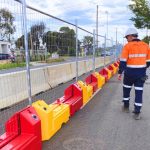Written by: Chris Briggs, University of Technology Sydney and Ruby Heard, The University of Melbourne
Done well, the renewable energy transition should improve the lives of First Nations Australians. Many are looking for ways to stay on Country, use their knowledge of Country and contribute to industries that align with their values.
Large-scale renewable energy projects and mines for critical minerals are often sited on lands with First Nations legal rights. Access arrangements should provide direct benefits to communities.
The clean energy sector also promises new employment opportunities in regional and remote areas.
We examined the barriers to increasing First Nations employment in clean energy, as well as the opportunities and solutions. Our new report, released today, makes 12 recommendations based on data analysis, modelling, interviews and workshops. Here’s how industry, government, educators and First Nations communities can create jobs and fulfilling careers in clean energy.
Closing the gap
There is a large, persistent gap between employment rates for First Nations Australians and non-Indigenous Australians.
About half of all First Nations Australians are employed. Compare that to almost two in three people in the wider population.
In September 2023, the Commonwealth government’s employment white paper noted the gap has “not closed notably” over the past 30 years. That’s despite waves of regional development including mining booms. Unfortunately, those First Nations people who do enter the workforce also often become stuck in short-term, low-paid casual roles.
Currently, relatively low numbers of First Nations Australians are working in clean energy.
Systemic disadvantage limits the opportunities available to First Nations Australians, particularly those living in regional and remote Australia.
Low literacy, numeracy and computer skills, poor access to relevant training, social and health issues, and a lack of transport to work and training are some of the main barriers.
Opportunities in renewable energy zones
Clusters of large-scale renewable energy projects are being developed in “renewable energy zones” across Australia.
On average, First Nation Australians make up a higher proportion of the population in renewable energy zones (6.2%) than Australia as a whole (3.8%).
This is especially true in major zones such as New England (9.4%) and Central-West Orana (12.7%) in New South Wales.
We investigated the scope for First Nations employment in renewable energy zones across South Australia, Tasmania, Victoria, NSW and Queensland.
We found three main groups of First Nations people could potentially find work in the renewable energy zones:
1. Other workers in key occupations
First Nations Australians are working in other sectors in occupations also in demand for renewable energy projects. The number of these workers equates to around 5–10% of the projected workforce in most renewable energy zones.
However, our analysis of census data found existing workers are concentrated in a handful of lower-skill occupations, such as truck drivers and construction labourers. Currently, there are few First Nations workers with the right skills. For example, just 87 electricians identify as First Nations Australians across all the renewable energy zones we examined.
2. School students
Based on census data, more than half the First Nations people in renewable energy zones are aged under 19. Programs that create awareness and interest in the renewable energy sector and build training pathways for students into renewables should be a priority.
3. Unemployed people and those not in the workforce
A handful of solar farms have hired First Nations people who were unemployed – usually in entry-level positions such as assembling solar panels, cleaning or traffic control.
Avonlie solar farm in Narrandera, NSW, hired 30 First Nations workers after putting them through pre-employment training. About 90% have gone on to other jobs afterwards. The social impact was transformational for a community with multiple generations of families who have never worked.
These projects are rare now, but this approach could be adopted elsewhere.
Our analysis shows First Nations employment targets of 5–10% in the renewable energy zones are currently challenging, but possible over time – especially if industry and government programs are implemented to create training and employment opportunities.
A 12-point plan for more First Nations jobs in clean energy
Training programs without concrete commitments from industry to providing a job at the end of it often become “training for training’s sake”. We found deep cynicism among First Nations people about whether the renewables sector would really deliver jobs for them.
Mandated employment targets can create demand for First Nations workers. But for industry to meet the targets requires having enough people with the right skills.
Our 12-point plan recommends a mix of “supply” measures (such as training) and “demand” measures (industry job commitments), such as:
- mandatory First Nations employment targets for solar farms combined with pre-employment programs to create a pipeline of candidates. Solar farm jobs are short-term (four to six months) but they can leave a positive legacy if they offer a way out of unemployment
- a coordinated program with wind farm operators for First Nations mechanical technicians to maintain turbines over their 20-year operating lifetime, to ease skills shortages and create long-term jobs on Country
- combining First Nations employment requirements in tenders for companies delivering Indigenous housing retrofits with training programs to create a pipeline of students for apprenticeships in key trades
- clean energy cadet programs that include commitments to a ten-year intake of First Nations students as cadets for university-qualified jobs, with government funding for specialist providers such as CareerTrackers to create, mentor and support a pipeline of students
- funding to help First Nations organisations engage with the clean energy sector, governments and other groups such as training bodies
- creating culturally safe workplaces in the renewable energy sector that provide career paths for First Nations Australians. This should include a focus on the development of cultural competency as well as internal policies that accommodate First Nations cultural obligations.
The long stagnation in First Nations employment rates across the past three decades highlights the challenges involved.
However, a First Nations clean energy jobs plan developed and implemented by industry, government and First Nations communities is essential if we are to ensure renewable energy delivers jobs for First Nations Australians – and breaks with the past.
Chris Briggs, Research Director, Institute for Sustainable Futures, University of Technology Sydney and Ruby Heard, PhD candidate in energy justice, The University of Melbourne
This article is republished from The Conversation under a Creative Commons license. Read the original article.







